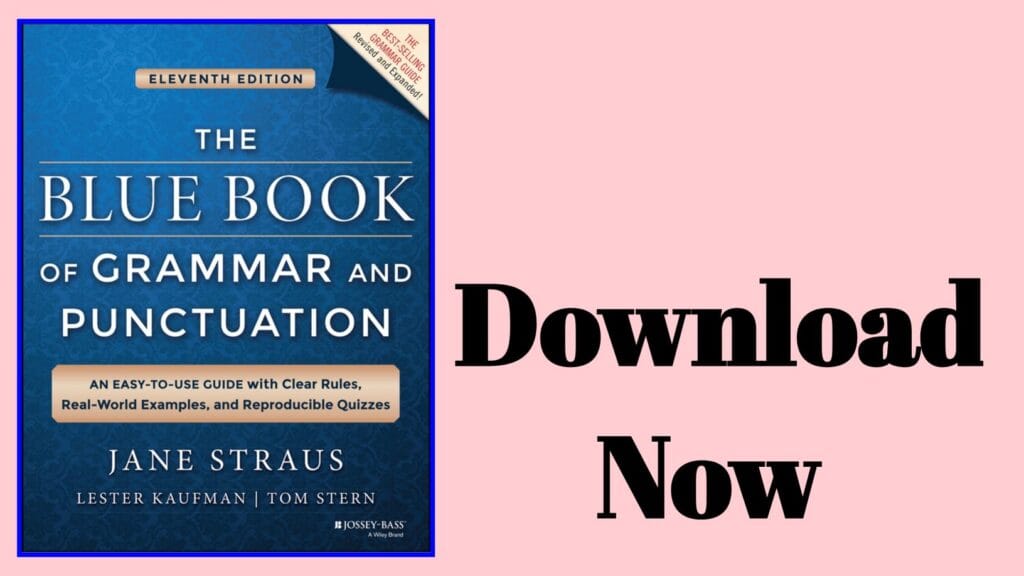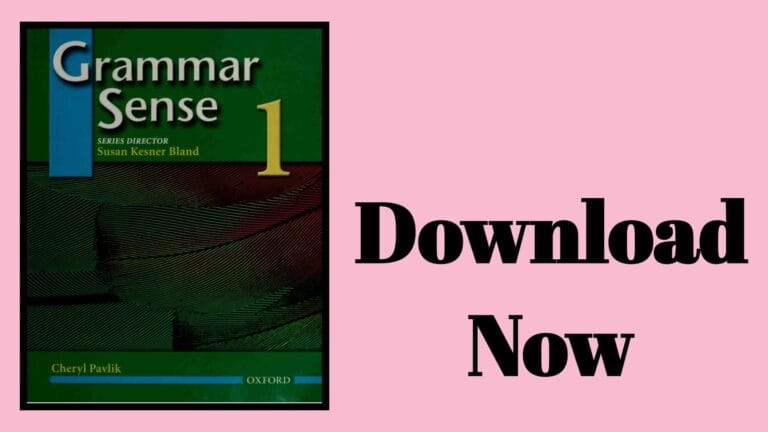
The Book Description
“The Blue Book of Grammar and Punctuation” is an easy to use grammar guide book that can be used for enhancing English grammar, especially writing skills. The book is written in a wonderful manner which consists of all the essential lessons to improve English grammar.
The contents of the book are really interesting which you will find when you go through the table of contents. It’s been made sure to include all the relevant grammar topics that are important to better your grammar skills. The name of the book suggests that the book is about grammar and punctuation skills.
The most important topics of the book include phrases, clauses, parts of speech, nouns, pronouns, verbs, adverbs, adjectives, conjunctions, prepositions, punctuation marks and their types, moods in grammar, writing numbers, capitalization, confusing words and homonyms, etc.
One of the most appealing features of the book is that it contains several quizzes that are related to nouns, verbs, prepositions, conjunctions, adjectives, adverbs, subject and object pronouns, subject verb agreement, confusing words, punctuation marks, effective writing and more like them.
Ideal Readers of the Book
The contents of the book suggest that the ideal readers are those students who have the basic knowledge about the English language. That is, they should be at the intermediate level of grammar who are looking for enhancing the writing skills and the overall skills of English grammar.
Thus, if you’re a beginner learner, you should avoid the book, because you can not extract much out of it. As the book focuses on the selective topics that are crafted to strengthen the grammar especially the writing skills of the readers. The book should be read by learners who are already knowledgeable about English language.
The Table of Contents
Preface and Acknowledgments
About the Authors
Introduction
1. GRAMMAR
Finding Nouns, Verbs, and Subjects
Definitions: Noun, Verb, Subject
Using verbs to find subjects
Multiple subjects and verbs in a sentence
Infinitives
You as an understood subject
Subject-Verb Agreement
Singular vs. plural verbs
Finding subjects before phrases beginning with “of”
With “or,” “either/or,” and “neither/nor”
Two singular subjects
One singular and one plural subject
With “and”
With interrupting expressions
With portions such as “percent,” “fraction,” “part,” etc.
With “here” or “there”
With distances, periods of time, sums of money, etc.
With collective nouns
The subjunctive mood
Clauses and Phrases
Definitions: Clause, Independent clause, Dependent clause, Phrase
Pronouns
Definition: Pronoun
Subject pronouns
As the subject of the sentence
Renaming the subject
When “who” refers to a personal pronoun
Object pronouns
Subject and verb agreement with “who,” “that,” and “which”
Subject and verb agreement with “anyone,” “someone,” “each,” etc.
Following “than” or “as”
Possessive pronouns: “Its” vs. “it’s,” “who’s” vs. “whose”
Reflexives: the “-self” pronouns
Consistency with singular pronouns
Pronouns linked with nouns by “and”
Who vs. Whom
He/him method
Common whom pitfalls
Whoever vs. Whomever
Agreement with the verb in the dependent clause
Dependent clause as the subject of the verb following the clause
Who, That, Which
“Who,” “that,” and “which” with people, groups, and things
“That” with essential clauses
“Which” with nonessential clauses
When “which” can be used with essential clauses
Adjectives and Adverbs
Definitions: Adjective, Adverb
Adjectives modifying nouns and pronouns
Adverbs modifying verbs, adjectives, and adverbs
When to add “-ly”
Sense verbs: taste, smell, look, feel, etc.
“Good” vs. “well”
Comparisons, such as “-er” vs. “-est” and “more” vs. “most”
“This,” “that,” “these,” and “those”
Prepositions
Definition: Preposition
Ending a sentence with a preposition
Avoiding extra prepositions
“Like”
“As,” “as if,” “as though,” “the way”
“Of” vs. “have”
“Different from” vs. “different than”
“In” vs. “into”
Effective Writing
Concrete vs. vague language
Active vs. passive voice
Overuse of “there is,” “there are,” “it is,” “it was,” etc.
Double negatives
Parallel construction
Dangling modifiers
Misplaced modifiers
Fragments
2. PUNCTUATION
Periods
With complete sentences
With abbreviations at the end of a sentence
Replacing periods with question marks and exclamation points
Commas
To separate three or more items
To separate adjectives
With two independent clauses
Run-on sentences or comma splices
Joined by connectors such as “and,” “or,” “but,” etc.
When the subject does not appear in front of the second verb
With introductory words
To set off interrupting expressions
With names
With dates
With city and state
With “Jr.” and “Sr.”
With degrees and titles
Starting a sentence with a dependent clause vs. an independent clause
With nonessential words, clauses, and phrases
With sufficiently identified nouns
With quotations
To introduce or interrupt quotations
Following quotations
To separate statements from questions
To separate contrasting parts of a sentence
With certain introductory words
When followed by a series of items
When the series of items ends with “etc.”
Semicolons
To replace a period in two closely linked sentences
With such words as “namely,” “however,” “therefore,” etc., when they introduce a complete sentence
To avoid confusion where commas already exist
With sentences that have multiple clauses
Colons
To introduce a series of items
Except when a series of items directly follows a verb or preposition
With lists
With two independent clauses when the second explains the first
With long quotations
After the salutation in a business letter
Quotation Marks
Use of double quotation marks
With titles of magazines, books, plays, etc.
With periods and commas (always inside quotation marks)
Use of single quotation marks for quotations within quotations
Spacing between single and double quotation marks
With nonstandard expressions
With technical terms and terms used in an unusual way
Avoiding single quotation marks
With quoted material of more than one paragraph
Parentheses and Brackets
Not interchangeable
Parentheses
For clarification and asides
With complete sentences
Subject-verb agreement
Comma placement with parentheses
Brackets
With interruptions
Use of “[sic]”
With quotations
Apostrophes
Singular nouns
Possession with singular nouns
Possession with common nouns ending in “s”
Possession with proper nouns ending in “s”
Plural nouns
Plural possession with regular nouns
No apostrophe with regular nouns
Plural possession with irregular nouns
Plural possession with names ending in “s”
No apostrophe with plural names
Possession with singular compound nouns
To show joint possession
Contractions
With initials, capital letters, and numbers used as nouns
With time or money
With personal pronouns
Apostrophes vs. single quotation marks
False possessives
With nouns ending in “y”
Hyphens
Hyphens between words
With compound adjectives
With compound verbs
With compound nouns
With “very” and “-ly” adverbs
With ages
For clarification
With spans of time, distance, or other quantities
With compound numbers
With spelled-out fractions
With double last names
Avoiding overuse
Look it up
Hyphens with prefixes and suffixes
Prefixes with proper nouns or proper adjectives
Prefixes with double vowels
With “self-,” “ex-,” and “all-”
With “re-” to avoid confusion
Suffixes not usually hyphenated
Suffixes and double letters
Using discretion and a dictionary
Dashes
Dashes and subject agreement
In place of other punctuation
Spacing
Ellipses
Definition and three-dot method
With omitted words or sentences
To express hesitation, changes of mood, etc.
Question Marks
With direct questions
Replacing periods
Capitalization following a question mark
Indirect questions
Rhetorical questions
With sentences that are half statement and half question
With quotation marks
Exclamation Points
To show emotion, emphasis, or surprise
Replacing periods
Avoidance in formal business writing
Justifiable use
3. CAPITALIZATION
First word of a document and after a period
Proper nouns and adjectives derived from proper nouns
Reference list of capitalized categories
Reference list of lowercase categories
Thorny aspects of capitalization
Titles vs. occupations
Titles in direct address
Kinship names
Nicknames
Geographic regions vs. points of the compass
“The” before proper nouns
City, town, county, etc., before a proper name
First word of a quotation
Midsentence independent clauses or questions
Course titles vs. academic subjects
Art movements
Lists following colons
Lowercase “the national anthem”
Titles of books, plays, films, songs, etc.
Subtitles
4. WRITING NUMBERS
Using figures vs. spelling out numbers
Numbers beginning a sentence
Hyphenating compound numbers
Hyphenating fractions
Figures of four or more digits
Sums less than a dollar
Noon and midnight
Time of day
Mixed fractions
Large numbers
Decimals
When to use “and”
Dates
Decades
Use lowercase when spelling out
Using apostrophes with incomplete numerals
Avoiding apostrophe + “s” with complete numerals
5. CONFUSING WORDS AND HOMONYMS
Imply vs. infer
Lay vs. lie
Their vs. there vs. they’re
Hundreds more words and homonyms that perplex and confound
6. QUIZZES
Grammar Pretest
Finding Nouns, Verbs, and Subjects Quiz 1
Finding Nouns, Verbs, and Subjects Quiz 2
Subject and Verb Agreement Quiz 1
Subject and Verb Agreement Quiz 2
Pronouns Quiz 1
Pronouns Quiz 2
Who, Whom, Whoever, Whomever Quiz 1
Who, Whom, Whoever, Whomever Quiz 2
Who, Whom, That, Which Quiz 1
Who, Whom, That, Which Quiz 2
Adjectives and Adverbs Quiz 1
Adjectives and Adverbs Quiz 2
Prepositions Quiz 1
Prepositions Quiz 2
Affect vs. Effect Quiz 1
Affect vs. Effect Quiz 2
Lay vs. Lie Quiz 1
Lay vs. Lie Quiz 2
Advice vs. Advise Quiz 1
Advice vs. Advise Quiz 2
Their vs. There vs. They’re Quiz 1
Their vs. There vs. They’re Quiz 2
More Confusing Words and Homonyms Quiz 1
More Confusing Words and Homonyms Quiz 2
Effective Writing Quiz 1
Effective Writing Quiz 2
Grammar Mastery Test
Punctuation, Capitalization, and Writing Numbers Pretest
Commas and Periods Quiz 1
Commas and Periods Quiz 2
Semicolons and Colons Quiz 1
Semicolons and Colons Quiz 2
Question Marks and Quotation Marks Quiz 1
Question Marks and Quotation Marks Quiz 2
Parentheses and Brackets Quiz 1
Parentheses and Brackets Quiz 2
Apostrophes Quiz 1
Apostrophes Quiz 2
Hyphens Between Words Quiz 1
Hyphens Between Words Quiz 2
Hyphens with Prefixes and Suffixes Quiz 1
Hyphens with Prefixes and Suffixes Quiz 2
Capitalization Quiz 1
Capitalization Quiz 2
Writing Numbers Quiz 1
Writing Numbers Quiz 2
Punctuation, Capitalization, and Writing Numbers Mastery Test
7. ANSWERS TO QUIZZES
Grammar Pretest Answers
Finding Nouns, Verbs, and Subjects Quiz 1 Answers
Finding Nouns, Verbs, and Subjects Quiz 2 Answers
Subject and Verb Agreement Quiz 1 Answers
Subject and Verb Agreement Quiz 2 Answers
Pronouns Quiz 1 Answers
Pronouns Quiz 2 Answers
Who, Whom, Whoever, Whomever Quiz 1 Answers
Who, Whom, Whoever, Whomever Quiz 2 Answers
Who, Whom, That, Which Quiz 1 Answers
Who, Whom, That, Which Quiz 2 Answers
Adjectives and Adverbs Quiz 1 Answers
Adjectives and Adverbs Quiz 2 Answers
Prepositions Quiz 1 Answers
Prepositions Quiz 2 Answers
Affect vs. Effect Quiz 1 Answers
Affect vs. Effect Quiz 2 Answers
Lay vs. Lie Quiz 1 Answers
Lay vs. Lie Quiz 2 Answers
Advice vs. Advise Quiz 1 Answers
Advice vs. Advise Quiz 2 Answers
Their vs. There vs. They’re Quiz 1 Answers
Their vs. There vs. They’re Quiz 2 Answers
More Confusing Words and Homonyms Quiz 1 Answers
More Confusing Words and Homonyms Quiz 2 Answers
Effective Writing Quiz 1 Answers
Effective Writing Quiz 2 Answers
Grammar Mastery Test Answers
Punctuation, Capitalization, and Writing Numbers Pretest Answers
Commas and Periods Quiz 1 Answers
Commas and Periods Quiz 2 Answers
Semicolons and Colons Quiz 1 Answers
Semicolons and Colons Quiz 2 Answers
Question Marks and Quotation Marks Quiz 1 Answers
Question Marks and Quotation Marks Quiz 2 Answers
Parentheses and Brackets Quiz 1 Answers
Parentheses and Brackets Quiz 2 Answers
Apostrophes Quiz 1 Answers
Apostrophes Quiz 2 Answers
Hyphens Between Words Quiz 1 Answers
Hyphens Between Words Quiz 2 Answers
Hyphens with Prefixes and Suffixes Quiz 1 Answers
Hyphens with Prefixes and Suffixes Quiz 2 Answers
Capitalization Quiz 1 Answers
Capitalization Quiz 2 Answers
Writing Numbers Quiz 1 Answers
Writing Numbers Quiz 2 Answers
Punctuation, Capitalization, and Writing Numbers Mastery Test Answers
Index


